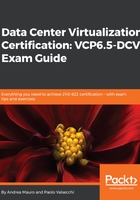
Configuring iSCSI port binding
As we stated previously, software and dependent hardware iSCSI adapters depend on a VMkernel networking configuration that should match the storage requirements.
Depending on the storage network interfaces, you can use multiple VMkernel adapters with multiple physical NICs with a 1:1 mapping.
The VMkernel adapters must be on the same subnets as the iSCSI storage system interfaces. If you have multiple subnets, then you will probably have multiple virtual switches. But if all the storage interfaces work in the same subnet, then you will use a single virtual switch and you must use the iSCSI port binding feature.
When you use port binding for multipathing, follow these requirements:
- iSCSI ports of the array target must reside in the same broadcast domain and IP subnet as the VMkernel adapters
- All VMkernel adapters used for iSCSI port binding must reside in the same broadcast domain and IP subnet
- All VMkernel adapters used for iSCSI connectivity must reside in the same virtual switch
To configure iSCSI port binding, first, create the VMkernel interfaces used for the iSCSI initiator. Be sure that each VMkernel adapter has only one active NIC as an uplink (the others should not be used).
Then, in the Configuration tab of each host, in the Storage | Storage Adapters menu, select the iSCSI adapter and then the Network Port Binding tab. Now, you can add desired adapters that will be used for the iSCSI initiator using the + icon:

Finally, perform the Rescan and Refresh operations.
For more information, see the vSphere 6.5 Storage guide (https://docs.vmware.com/en/VMware-vSphere/6.5/com.vmware.vsphere.storage.doc/GUID-0D31125F-DC9D-475B-BC3D-A3E131251642.html) or the VMware KB 2038869 (https://kb.vmware.com/s/article/2038869)—considerations for using software iSCSI port binding in ESX/ESXi.